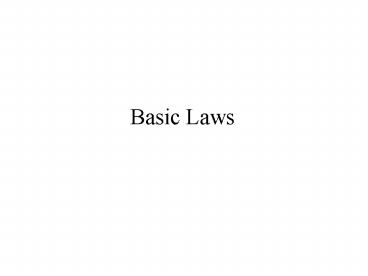Basic Laws - PowerPoint PPT Presentation
1 / 33
Title:
Basic Laws
Description:
Series Resistors and Voltage Division. Parallel Resistors and ... Potentiometer (pot) Open circuit. Short circuit. Nonlinear Resistors. i. v. Slope = R. v ... – PowerPoint PPT presentation
Number of Views:90
Avg rating:3.0/5.0
Title: Basic Laws
1
Basic Laws
- Instructor Chia-Ming Tsai
- Dept. of Electronics Engineering
- National Chiao Tung University
2
Contents
- Ohms Law (resistors)
- Nodes, Branches, and Loops
- Kirchhoffs Laws
- Series Resistors and Voltage Division
- Parallel Resistors and Current Division
- Wye-Delta Transformations
3
Ohms Law
- Resistance R is represented by
- Ohms Law
1 ? 1 V/A
ohm
4
Resistors
Open circuit
Short circuit
Variable resistor
Potentiometer (pot)
5
Nonlinear Resistors
Linear resistor
Nonlinear resistor
v
- Examples lightbulb, diodes
- All resistors exhibit nonlinear behavior.
6
Conductance and Power Dissipation
- Conductance G is represented by
positive R power absorption () negative R
power generation (-)
7
Nodes, Branches, Loops
- Branch a single element (R, C, L, v, i)
- Node a point of connection between branches (a,
b, c) - Loop a closed path in a circuit (abca, bcb, etc)
- An independent loop contains at least one branch
which is not included in other indep. loops. - Independent loops result in independent sets of
equations.
redrawn
8
Continued
Elements in series
Elements in parallel
- Elements in series
- (10V, 5?)
- Elements in parallel
- (2?, 3?, 2A)
- Neither
- ((5?/10V), (2?/3?/2A))
9
Kirchhoffs Laws
- Introduced in 1847 by German physicist G. R.
Kirchhoff (1824-1887). - Based on conversation of charge and energy.
- Two laws are included, Kirchhoffs current law
(KCL) and Kirchhoffs votage law (KVL). - Combined with Ohms law, we have a powerful set
of tools for analyzing resistive circuits.
10
KCL
- Assumptions
- The law of conservation of charge
- The algebraic sum of charges within a system
cannot change. - Statement
- The algebraic sum of currents entering a node (or
a closed boundary) is zero.
11
Proof of KCL
12
Example 1
13
Example 2
14
Case with A Closed Boundary
Treat the surface as a node
15
KVL
- Assumption
- The principle of conservation of energy
- Statement
- The algebraic sum of all voltages around a closed
path (or loop) is zero.
16
Proof of KVL
i
17
Example 1
Sum of voltage drops Sum of voltage rises
18
Example 2
19
Example 3
Q Find v1 and v2.
Sol
20
Example 4
Q Find currents and voltages.
Sol
21
Series Resistors
22
Voltage Division
23
Continued
24
Parallel Resistors
25
Current Division
26
Continued
27
Brief Summary
28
Example
29
How to solve the bridge network?
- Resistors are neither in series nor in parallel.
- Can be simplified by using 3-terminal equivalent
networks.
30
Wye (Y)-Delta (?) Transformations
Y
T
?
?
31
? to Y Conversion
32
Y-? Transformations
33
Example































